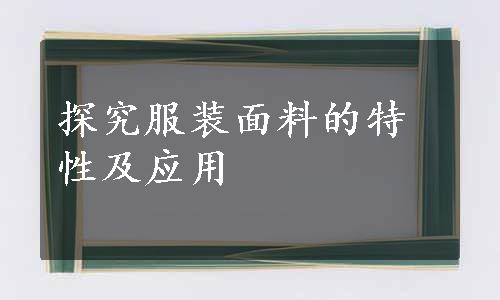
Clothing fabrics are mainly used to make garments,which are often required to have beautiful appearance,comfortable touch,soft luster,lasting setting effect and better unstained capability.At the same time,in order to meet the requirements that clothes are easy to wear and take off,it is also necessary for the fabrics to have a certain flexibility and elastic reversion.For some clothes using in extraordinary circumstances,the fabrics used also need to have some unique functions.
服用织物主要用于制作服装,往往要求具有美丽的外观、舒适的触感、柔和的光泽、持久的定形效果及较好的抗污、去污能力。同时,为了满足服装容易穿脱的要求,织物还需具有一定的弹性回复能力。而对一些有特殊要求的服装,所采用的织物还需具有一些特定的功能。
Clothing fabrics usually include light fabrics,middle thick fabrics and heavy fabrics.The light fabrics are generally used to produce summer clothing,which should have some properties such as cool,breathing freely,water vapor penetrating,skin untouching,uncockling,good setting and few static,which can withstand high temperature and make us cool,comfortable and beautiful when we put on their dress in summer.The middle thick fabrics are mainly used in the production of underwear,spring and autumn clothing and so on.And the heavy fabrics are mainly used to make winter coats and fineries,such as business suits,jackets,overcoats,scarves and others.The warmth retention of the fabrics is one of the main factors to be considered in the design.For that,the fabrics are usually woven from some textile materials with good warmth retention,such as wool,cotton and others.For some fuzzes on the surface,the weaving stray is indistinctive.But on the surface of light fabric,the weaving stray is very distinctive.
服用织物通常包括轻薄织物、中厚织物和厚重织物。轻薄织物一般用于生产夏季服装,需要具备凉爽、透气、透湿、不粘皮肤、不易折皱、保形性好、不易产生静电的特性,才能使人们在夏季穿着时感觉凉爽、舒适,外形美观,以抵抗高温。中厚织物主要用于生产内衣、春秋季服装等。而厚重织物则主要用于生产冬季外套服装、服饰,如西装、夹克、大衣等服装及围巾等。织物的保暖性是在设计时需要考虑的主要因素之一,因此,织造时织物往往选用一些保暖性好的纺织材料,如羊毛、棉等材料。厚重织物的表面一般具有一些毛绒,因而织物的外观纹路比较模糊,但在轻薄织物中,织物的纹路非常清晰。
Clothing fabrics are usually woven from simple weaves on the simple rapier loom,water jet loom,air jet loom and projectile loom.Some figured weave fabrics can be sometimes woven by dobby loom.At present,clothing fabrics with jacquard weaves are relatively rare.The motif and color of the fabrics are usually made by colored weaving,dyeing and printing.Many clothing fabrics also use a variety of textile materials with different properties to take more colorful floral pattern of fabrics through blending,interlacing means.
服用织物的织造一般采用简单的组织,在一般的剑杆织机、喷水织机、喷气织机及片梭织机上就可以完成。一些小提花织物有时也采用多臂织机进行织造。目前,服装面料采用大提花织物的还比较少见。面料的图案及花色多采用色织、染色、印花等方式来完成。许多面料还采用多种不同性能的原料通过混纺、交织的手段使服用织物的花色更加丰富多彩。
Based on the fabric composition,clothing fabrics can be classified into:cotton fabric,linen fabric,woolen fabric,silk fabric,chemical fiber/man-made fiber fabric,knitted fabric,fur and leather fabric.The following is a brief introduction to the characteristics of various fabrics。
(1)Cotton fabric:It is a general term for all kinds of cotton textiles.Its advantages are light and warm,soft and close to the body,of good moisture absorption and air permeability,good dyeing performance,soft gloss,etc.The disadvantages are easy-shrinking,easy-frilling,not very nice in appearance,and ironing frequently when wearing.It is often used to make underwear,shirts,skirts,leisure wear and fashion.
(2)Woolen fabric:It is a universal term for all kinds of woolen and cashmere fabrics.The merits are wrinkle-resistant and wearable,soft-to-touch,elegant and crisp,elastic and warm,not easy to fade,etc.The drawbacks are difficult in washing,easy in shrinking,pilling,and being damaged by moth,and poor in heat-resistance.It is usually only suitable for making high-quality clothes,such as formal dresses and business suits.
(3)Silk fabric:The strong points are light and soft,smooth and comfortable,elegant and gorgeous,bright color,anti-ultraviolet,good moisture absorption and release,etc.The weak points are creasing and fading easily,and are not resistant to light.Silk is often adapted to a variety of summer and high-end clothes,especially for women's wear.
(4)Linen fabric:There are many kinds of hemp fiber,but only soft hemp fiber like ramie,flax,jute and others can be used as textile materials.It has the advantages:high strength,good heat conductivity,good moisture absorption,good air permeability,not easy to be affected by damp and mildew and to fade,bright color and so on.It is generally used for summer wear,leisure wear and work wear.
(5)Chemical fiber/man-made fiber fabric:It includes chemical fiber and synthetic fiber.It has a wide range of uses and can be used to make all kinds of clothing ranging from low to medium price.Their common advantages are colorful,soft,draping,crisp,smooth and comfortable.The disadvantages are their poor abrasion resistance,moisture absorption,air permeability,tendencies towards static,etc.(www.xing528.com)
(6)Fur and leather fabrics:Fur and leather are precious clothing fabrics.Generally,the animal fur after tanning is called fur,while the processed smooth or suede is called leather.Fur is an ideal material for winter clothing with virtues like warm,light,durable and both dignified and graceful.Leather after dyeing treatment can get a variety of appearance style,be loved by people.The shortcomings are expensive in price and hard in storage and care.They are applied to fashion and winter wear.
按照织物成分,服用面料可分为:棉织物、麻织物、毛织物、丝绸织物、化学纤维面料、针织品类面料、裘皮及皮革面料。以下简要介绍各种织物的特性。
(1)棉织物:是各类棉纺织品的总称。具有轻松保暖、柔软贴身、吸湿性好、透气性好、染色性能好、光泽柔和等优点。缺点则是易缩、易皱,外观上不大挺括美观,穿着时时常需要熨烫。常用来制作内衣、衬衣、裙子、休闲装和时装。
(2)毛织物:是对各类羊毛、羊绒织成的织物的泛称。具有抗皱耐磨、手感柔软、高雅挺括、富有弹性、保暖性强、不易褪色等优点。缺点是洗涤困难、易缩水、易起球、易被虫蛀、耐热性差。通常适用于制作礼服、西装等高档服装。
(3)丝绸织物:具有质轻柔软、平滑舒适、高雅华丽、色泽鲜艳、抗紫外线、吸湿性好、放湿性好等优点。缺点是易产生折皱和褪色,不耐光照。常被用来制作各种夏装和高档服装,尤其是女装。
(4)麻织物:麻纤维有很多品种,但能作为纺织纤维材料的只有苎麻、亚麻、黄麻等几种软质麻纤维。具有强度高、导热性好、吸湿性好、透气性好、不易受潮发霉、不易褪色、色泽鲜艳等优点。一般用来制作夏装、休闲装和工作装。
(5)化纤面料:包括化学纤维与合成纤维两大类。用途十分广泛,可用于制作各类服装,但总体档次不高。它们的共同优点是色彩鲜艳、质地柔软、悬垂挺括、滑爽舒适。缺点则是耐磨性差、吸湿性差、透气性差、容易产生静电等。
(6)裘皮及皮革面料:裘皮与皮革是珍贵的服装面料,一般把鞣制后的动物毛皮称为裘皮,而把经过加工处理的光面或绒面皮称为皮革。裘皮是防寒服装理想的材料,取其保暖、轻便、耐用、雍容华贵的品质。皮革经过染色处理后可得到各种外观风格,深受人们的喜爱。缺点则是价格昂贵,储藏、护理方面要求较高。多用于制作时装和冬装。
According to the structure,clothing fabrics are divided into three categories:woven fabric,knitted fabric and nonwoven fabric.Woven fabrics and knitted fabrics have been introduced in the previous texts and will not be repeated here.Nonwoven textiles may be divided into two categories:disposable products and durable products,the former being those that are made to be disposed of after a single or limited number of uses;the latter being those which are of multi-use,i.e.,not be thrown away after a single application.
按照组织结构,服用织物面料又分为三大类:机织面料、针织面料与非织造布。机织面料和针织面料前面课文已有介绍,这里不再赘述。非织造纺织品可分为用即弃型和耐久型两类产品,前者系指用过一次或有限次数后即废弃不用;后者则指可用多次,亦即用过一次后并不丢弃,仍继续使用。
免责声明:以上内容源自网络,版权归原作者所有,如有侵犯您的原创版权请告知,我们将尽快删除相关内容。




